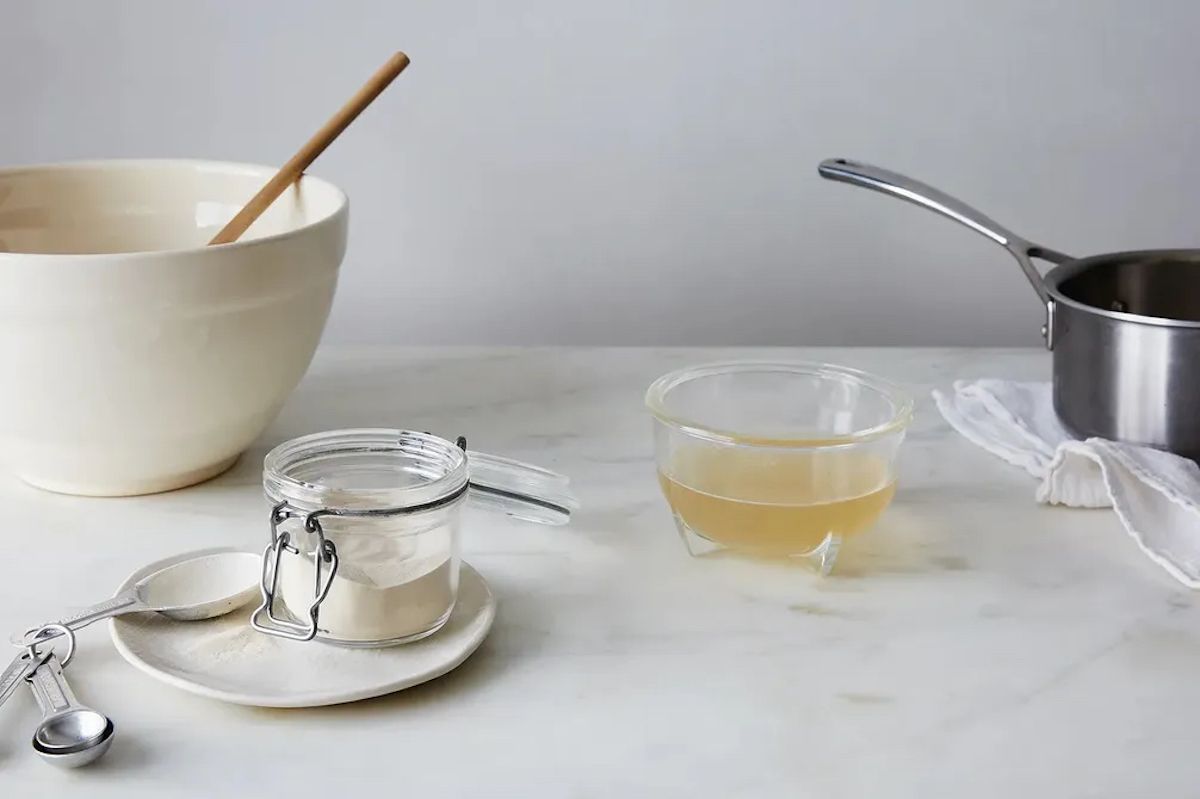Gelatin is not vegetarian. This is not a surprise to you. The good news is that there is a vegan substitute for gelatin called agar-agar, which is a product derived from algae. Agar-agar looks and acts similar to gelatin, but it's made without any animal products at all, making it just right for any home cook or baker. What might be a surprise — especially if you're not vegetarian, vegan, or avoiding pork for any reason — is just how many things include gelatin as an ingredient. Marshmallows, many chewy candies, panna cotta. Jell-O. All of them owe their texture to gelatin, in all its swingy, bouncy, jiggly, chewy glory. I've been crossing my fingers, as a vegetarian, for a gelatin substitute that would replicate that texture perfectly. But alas, even the staunchest of vegans would admit that nothing can match gelatin's elastic, jolly properties. However, there is one product that may come close — the algae-derived agar-agar, aka agar. Ahead, find out exactly what agar is and how to use it in place of gelatin.
* * *
What is agar?
Agar, which you can buy in health food or Asian specialty food stores (usually in either powder or flake form), is a thickening and gelling agent, and most use it to make a firm, Jell-O-like food. You use it the same way you would gelatin, too: Dissolve and hydrate the agar in warm liquid and let set. Agar is one of those ingredients — like wheatgrass, hummus, and sprouted bread — that sounded like the punchline in a health-conscious parent's kid's lunch box, until it became cool: Although agar-agar has been used for centuries in Asian cooking (it was discovered in Japan in the 17th century), it has been seeing popularity elsewhere, especially in vegan cooking (see: the raindrop cake's debut at Brooklyn food festival Smorgasburg, where it goes for a cool $8 a pop). You may also recognize agar-agar from your chem lab days: The stuff folks cook with is the same stuff that's poured into Petri dishes for culturing bacteria.
* * *
Are gelatin and agar-agar the same?
Agar-agar can often be used as a substitute for gelatin or even cornstarch, another popular thickening agent. It should be noted that agar-agar does have a couple of major differences from gelatin: A liquid set with agar won't be a perfect replica of one set with gelatin. There's even a product called agar gel, which is surprisingly quite firm! As Victoria Belanger, blogger and author of Hello, Jell-O!, told me over the phone, agar gel "bonds horizontally and cleaves vertically," resulting in a gel that is rubbery one way and flakey the next (unlike gelatin gel, which will jiggle softly and consistently until it's down your gullet). Additionally, since agar-agar in very small amounts produces something a bit jammy in texture, many people use it when making, well, jam.
* * *
How to use agar-agar
What's more, use too much and you'll be surprised with something very surprising indeed: plasticky, drum-taut, unpleasant to eat. And yet, it's hard to know exactly how much to use — resources vary hugely on just about everything agar-related, including what it can or can't be used for, how much to use, whether or not to boil the liquid and for how long . . . And this can be very discouraging to the agar-curious.
I experimented with making agar-agar gel using blackberry juice (inspired by Amanda Hesser's Blackberry Fluff) and bottled sweet tea; in my blackberry juice experiments, I tried to follow Amanda's recipe, simply subbing agar-agar for gelatin 1:1, as some advise. The result was that rubbery, over-gelled thing; it did not want whipped cream folded into it, as the Blackberry Fluff recipe instructs, and when instead I mashed up the gel as best I could to fold the cream in, it gelled the cream, too. (Very weird.) Next, I tried a series of experiments with the tea, beginning the same proportion of liquid to agar as the Blackberry Fluff advises (1 3/4 cups liquid to 1 1/2 teaspoons agar-agar), decreasing the amount of agar each time: 1 1/2 teaspoons, 1 teaspoon, 1/2 teaspoon — and while the first two experiments were similarly rubbery, the last, with the least agar, was looser, smoother, and spoonable.
I am (clearly) not an agar-agar expert, nor is Victoria (whose first love is gelatin-based gels), but we agreed on the following:
- Agar is not a 1:1 substitute for gelatin. I had the most success substituting agar-agar for between a third and half the amount of gelatin called for (so, a little more than 1/2 teaspoon agar when the recipe called for 1 1/2 teaspoons gelatin for 1 3/4 cups liquid). Victoria recommends using about half the amount of agar as a recipe with gelatin would call for, or about 1 teaspoon agar per 3 cups liquid. Err on the side of caution: No matter what recipe you're using agar in, you'll probably need to do some experimentation to get the texture just right.
- Agar sets very quickly, and at room temperature! There are good and bad parts to this: You don't have to wait around for agar-agar like you do for gelatin. It's also stays stable when hot (up to 185° F!) and cold, unlike gelatin, which melts in heat. (You can even remelt it a few times and it will maintain its properties.) But you also have to have all your pieces in place before you begin: whisk, pot, liquid, mold. (Also, if you're using a mold, grease it first. Agar won't slide right out the way gelatin gel will.)
- It's best with fairly simply recipes. Victoria's had trouble layering and adding booze to agar gels. (Others warn that more acidic liquids, like orange juice, won't set up.) But she has had success with vegan panna cotta and molded gels, like this watermelon-basil one.
- Don't simmer longer than a few minutes. Many recipes advise simmering the agar-agar with the liquid, but Victoria and I found a very short simmer, 4 to 5 minutes, was all it took to activate the agar (and that simmering longer made rubbery gel more likely). Victoria only brings her agar-liquid mix up to a boil before removing it from the heat and pouring it into a mold. If it doesn't seem like your gel is starting to set up as soon as you pull it off the heat (which it should), fear not: You can just return it to the pot and simmer for a few more minutes.
- Whisk very thoroughly — or use an immersion blender — to fully incorporate the powder into the liquid. It may help to add just a splash of liquid at a time to the agar, then whisk to combine, forming a homogeneous paste, before adding more liquid. This will help the liquid and agar combine and set evenly.
* * *
Agar-agar recipes
Orange Blossom Honey Panna Cotta
Agar-agar powder is used in place of gelatin in this citrusy panna cotta recipe. A trio of orange ingredients — orange zest, orange blossom honey, and segmented oranges — bring brightness to each bite.
Vegan Coconut-Lime Panna Cotta with Mango Jam
Oat milk and agar powder are the two secret ingredients that make this tropical panna cotta recipe completely vegan.
Raspberry and White Chocolate Tart with Cocoa Crust
"This tart is not only pretty, its flavors are elegant and sophisticated, and its texture is out of this world; no one would ever know that it has no dairy, eggs, or gluten and consists of whole-food ingredients," says recipe developer Amy Chaplin. Agar-agar flakes are used in the raspberry and white chocolate filling for a smooth, firm texture.
Vegan Macadamia-Coconut Panna Cotta
In this sweet and subtly nutty vegan panna cotta recipe, agar-agar flakes are used to create the gelatinous consistency and provide body. Agar-agar is cooked with homemade macadamia-coconut milk until the liquid starts to thicken and the flakes have fully dissolved.


Shares